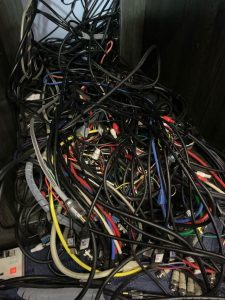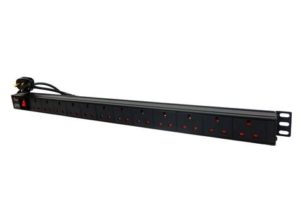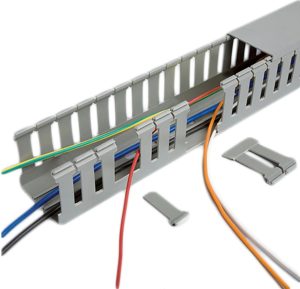AV Guides, Games Room Equipment, Games Rooms, Howto & Guides
Building our New Games Room – Part 7 – Taming your Cables
Welcome to the seventh instalment of our games room build. This time we’re going to look at the thorny subject of cable management. If you are planning a room with multiple consoles or computers in it, it is no exaggeration to say that lack of cable management can derail your project and cause endless misery. With that in mind, let’s look at what we can do to make the situation a little more manageable.
The cable management paradox

Most cable management solutions focus on tidying cables away neatly, so that they don’t look unsightly or, crucially, don’t tangle themselves up with other cables. From trunking to simple cable ties, these solutions are great, until you want to change a cable. At that point, it may be significantly harder to swap out a cable that’s buried in trunking, than one that’s just left loose.
However, unless you have a very simple setup, if you simply leave all your cables in a big pile, swapping and changing them won’t be easy either. This is because, invariably, the cable you need to swap will get buried at the bottom of a large pile of other cables, tangled in amongst them and it will take a significant amount of time to untangle and remove it. Indeed, the less cable management you do, the more this becomes a problem.
Do not fall into the trap of thinking that “out of sight is out of mind” either. Badly managed cables hidden behind a unit can cause all sorts of problems. The sheer weight of unmanaged cables running close to each other can pull on connected cables, causing them to disconnect. With larger switches, like the Extron Crosspoint, the weight of the cables behind the switches can even push the switch itself forwards, off of the shelf you installed it on. Reaching around the back of your switch to reconnect one cable will cause others to disconnect, causing a negative feedback loop of frustration.
Initially, with poor cable management in our media unit we encountered all these problems, but thanks to a few simple improvements they are almost entirely eliminated now.
Manage what you can
A good starting point for planning your cable management strategy is to consider which of your cables are unlikely to be changed or upgraded in the foreseeable future. Speaker cables, for instance, haven’t changed significantly in the last few decades. Older Ethernet cables may not carry the same bandwidth as more modern ones, but that hardly matters if you’re connecting to retro gaming consoles that will forever have 10/100 network adapters.
Analogue video is a little more tricky as you may want to swap analogue connections for HDMI if and when HDMI mods are created for your favourite retro consoles. For HDMI cables, consider (if you haven’t upgraded already) that the jump to HDMI 2.1 may require a new cable. Perhaps the PS6 and the next generation Xbox may need a HDMI 2.2 cable, but for your PS3, Xbox 360 and HDMI modded retro consoles, the cables you have now will not need replacing.
These cables that you identify as unlikely to ever need replacing can be placed inside trunking, tubing or other cable management solutions. For the cables that might need to be replaced, manage more moderately with Velcro cable ties for instance.
Make use of walls

Dumping all your cables in a big pile on the floor isn’t a good strategy, so make use of vertical space as well. If your cabinet is against a wall, as most are, mount trunking, power strips, Ethernet or even video switches on the back wall and route cables neatly to them. If you mount trunking on the wall, you can route cables both through it and on top of it, ideal for those pesky cables you might need to change in the future. If you can’t physically drill into the wall you can still mount lighter things like smaller network switches using heavy duty Velcro tape.
If your room can accommodate it, consider providing access to the rear of your media unit/gaming setup. If you can actually access the back of everything to cable things up, connecting and tidying your cables becomes much easier. Some designers even incorporate caster wheels on their media units so that the whole thing can move forward to allow access to the back. Of course, in a more space restricted room this is unlikely to be possible.
Remember that a little goes a long way. Cable management can seem daunting especially with more complex builds but it’s better to do some than none at all. If you still end up with a pile of cables on the floor, it’s better than an even bigger pile.
Recommended cable management products

Slotted panel trunking – For trunking that runs behind your media unit, this cheap slot trunking is great for holding multiple cables. To break a cable out simply prise off one of the teeth and route the cable through. They work well on the floor or mount easily to a wall using a Rawlplug and a drill.
In our build we used several runs of this trunking, one on the floor contained our speaker wires, while two mounted on the wall behind the unit contained network, HDMI and other miscellaneous cables. If your trunking needs to run in a more visible location you might want to consider Perimeter or Dado trunking instead. Screwfix sell a range of such trunking here.
Spiral cable wrap – Available in different lengths and thicknesses, spiral cable wrap simply wraps around several cables, making one big, thick and less likely to snag cable out of several thinner and more troublesome ones. While you can use it to wrap longer lengths of cable, it’s also useful in shorter lengths just to keep the end of a cable run together too.
Wall plates – Several AV manufacturers make wall plates for connecting AV equipment. This lets you route cables through your cabinet or even through cavity walls, you can then use a separate cable to connect between the wall plate and your AV equipment. While we didn’t use these in our current build, we did use them way back in our old games room in Lincoln and wrote about them here. The biggest disadvantage of this system is how difficult it is to swap cables, for example if you change from using component video to HDMI, you will need a new panel and to remove the cable from the wall.
Cable management panels for AV racks – If we were designing our media unit again, we would have definitely incorporated some simple panels like these into the rear of the rack unit. Panels such as this one provide simple access routing holes for cables going to your AV switches or video processors. Particularly if you have several switches or devices in the same vertical stack, these will help make sure your cables stay routed in the right direction and don’t tangle with cables going to a different destination.
Velcro cable ties – These hardly need an explanation, for quick and simple cable management, tie your cables together with this easily removed Velcro fastening. Ideal for short term cable runs or just to tidy up the last few inches of a run once it breaks out of the trunking.
With the subject of cable management covered, we’re nearing the end of this series and getting close to a completed build. Next time we’ll discuss choosing furniture and shelving for your dream games room. You can now read that part by clicking here.

